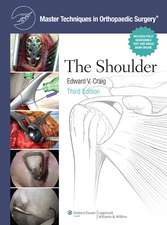Biomechanics of Lower Limb Prosthetics
Autor Mark R. Pitkinen Limba Engleză Hardback – 19 noi 2009
| Toate formatele și edițiile | Preț | Express |
|---|---|---|
| Paperback (1) | 834.40 lei 6-8 săpt. | |
| Springer Berlin, Heidelberg – 13 dec 2014 | 834.40 lei 6-8 săpt. | |
| Hardback (1) | 1079.90 lei 38-45 zile | |
| Springer Berlin, Heidelberg – 19 noi 2009 | 1079.90 lei 38-45 zile |
Preț: 1079.90 lei
Preț vechi: 1136.74 lei
-5% Nou
Puncte Express: 1620
Preț estimativ în valută:
206.65€ • 220.97$ • 172.29£
206.65€ • 220.97$ • 172.29£
Carte tipărită la comandă
Livrare economică 14-21 aprilie
Preluare comenzi: 021 569.72.76
Specificații
ISBN-13: 9783642030154
ISBN-10: 3642030157
Pagini: 187
Ilustrații: XVII, 141 p.
Dimensiuni: 155 x 235 x 15 mm
Greutate: 0.43 kg
Ediția:2010
Editura: Springer Berlin, Heidelberg
Colecția Springer
Locul publicării:Berlin, Heidelberg, Germany
ISBN-10: 3642030157
Pagini: 187
Ilustrații: XVII, 141 p.
Dimensiuni: 155 x 235 x 15 mm
Greutate: 0.43 kg
Ediția:2010
Editura: Springer Berlin, Heidelberg
Colecția Springer
Locul publicării:Berlin, Heidelberg, Germany
Public țintă
ResearchCuprins
LOWER LIMB PROSTHESIS.- Importance of Increasing the Functionality of Lower Limb Prostheses.- Normalization of the Gait Characteristics as a Means to Increase a Prosthesis’s Functionality.- Lower Limb Prosthesis as Biotechnical System.- BIOMECHANICS OF NORMAL GAIT AND CRITERIA OF THE ANTHROPOMORPHICITY OF PROSTHESIS.- Methods of Gait Analysis.- Ballistic Gait in Norm.- BALLISTIC GAIN ON PROSTHESIS.- Active and Passive Moments In Joints.- Model of the Step Cycle.- Compensatory Synergy During Gait on Prosthesis.- Modeling of One-Leg Balancing.- THEORY OF DESIGNING THE ANTHROPOMORPHIC LOWER LIMB PROSTHESES.- Synthesis of a Mechanism of Artificial Prosthetic Joint.- Development and Testing of the Prosthetic Ankle.- Development and Testing of the Prosthetic Knee Joint.- TESTING OF THE EXPERIMENTAL PROSTHESES.- Program.- Results.- Biomechanical Testing of the Rolling Foot with Adjustable Stiffness.- Monitoring.- PRINCIPLE OF SPECTRAL RECIPROCITY IN BIOMECHANICS OF LOCOMOTION AND REHABILITATION.
Recenzii
From the reviews:
“The textbook delivers an excellent overview of the various facets of lower limb prosthetic design and engineering. It can be useful to the professionals who develop the prostheses and who prescribe them. … The monograph by Professor Pitkin already has been and will be a must component of the curriculum in biomechanics, rehabilitation and prosthetics as an important source of ideas and methodology, especially for young devoted professionals.” (Konstantin Shcherbina, Prosthetics and Orthotics International, February, 2014)
“This book describes how biomechanical principles and theories can be applied to the development and testing of new prosthetic componentry. … clinicians will find that … the book helps them understand the basis of hypothesis testing and the various tools, including force plates, socket interface measurements, and computer models, available to researchers to evaluate prosthetic componentry and biomechanical ideas. … Researchers and students will find value in the experiences of the author in the development and testing of the rolling joint technology … .” (Laura A. Miller, Doody’s Review Service, January, 2011)
“Pitkin’s work serves as a foundation for designing and manufacturing contemporary lower limb prosthetics. … Biomechanics of Lower Limb Prosthetics is well written and easy to read, considering its heavy emphasis on biomechanical principles and theories. … the book does summarize current understanding of basic movement concepts, measurements, and challenges for future design and so should appeal to the academician and prosthetist and serve as an invaluable tool for prosthetic research.” (Brian M. Kelly, Journal of the American Medical Association, Vol. 304 (21), December, 2010)
“The textbook delivers an excellent overview of the various facets of lower limb prosthetic design and engineering. It can be useful to the professionals who develop the prostheses and who prescribe them. … The monograph by Professor Pitkin already has been and will be a must component of the curriculum in biomechanics, rehabilitation and prosthetics as an important source of ideas and methodology, especially for young devoted professionals.” (Konstantin Shcherbina, Prosthetics and Orthotics International, February, 2014)
“This book describes how biomechanical principles and theories can be applied to the development and testing of new prosthetic componentry. … clinicians will find that … the book helps them understand the basis of hypothesis testing and the various tools, including force plates, socket interface measurements, and computer models, available to researchers to evaluate prosthetic componentry and biomechanical ideas. … Researchers and students will find value in the experiences of the author in the development and testing of the rolling joint technology … .” (Laura A. Miller, Doody’s Review Service, January, 2011)
“Pitkin’s work serves as a foundation for designing and manufacturing contemporary lower limb prosthetics. … Biomechanics of Lower Limb Prosthetics is well written and easy to read, considering its heavy emphasis on biomechanical principles and theories. … the book does summarize current understanding of basic movement concepts, measurements, and challenges for future design and so should appeal to the academician and prosthetist and serve as an invaluable tool for prosthetic research.” (Brian M. Kelly, Journal of the American Medical Association, Vol. 304 (21), December, 2010)
Textul de pe ultima copertă
The most outstanding feature of "Biomechanics of Lower Limb Prosthetics" is the demonstration of the practicality of biomechanics, when applied to lower limb prosthetics. Several original concepts are described, one of which, "rolling technology," has been implemented in prosthetic devices, while the principle of "reciprocal anti-resonance in locomotion" addresses future studies. A concept of anthropomorphicity presented by the author is a key tool in planning the design of an artificial limb or its components.
Measurement procedures and equipment used in biomechanical laboratories are presented. The book demonstrates how the analysis of biomechanical data is a tool in the decision-making process of a prosthetic designer and clinician. The author shares his experience in the development of a protocol for biomechanics subject trials used in NIH-supported studies.
Measurement procedures and equipment used in biomechanical laboratories are presented. The book demonstrates how the analysis of biomechanical data is a tool in the decision-making process of a prosthetic designer and clinician. The author shares his experience in the development of a protocol for biomechanics subject trials used in NIH-supported studies.
Caracteristici
Practical approach to the use of biomechanics in prosthetics State of the art presented by leading expert in the field Clearly structured "hands on" reference work Includes supplementary material: sn.pub/extras













